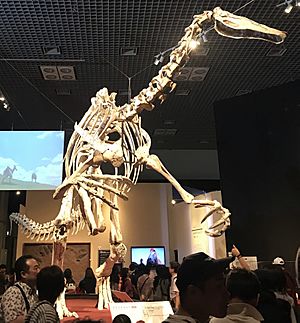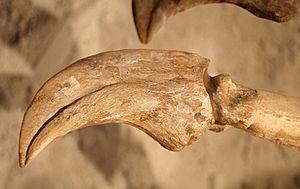Deinocheirus facts for kids
Quick facts for kids Deinocheirus |
|
|---|---|
 |
|
| Reconstructed skeleton in Japan | |
| Scientific classification | |
| Genus: |
Deinocheirus
|
| Species: |
mirificus
|
Deinocheirus (say it: DY-no-KY-rus) was a very unusual dinosaur. It lived in what is now Mongolia during the Late Cretaceous period, about 71 to 69 million years ago. This dinosaur belonged to a group called ornithomimids, which means "bird-mimic" dinosaurs. These dinosaurs often looked a bit like ostriches.
When scientists first found parts of Deinocheirus in 1965, they only discovered its giant arms and shoulder bones. These arms were so big, they thought it must have been a huge, scary predator! But then, in 2014, more fossils were found. These new discoveries showed that Deinocheirus was actually a very strange-looking dinosaur. It was probably an omnivore, meaning it ate both plants and small animals.
Contents
Discovering the "Horrible Hand"
The name Deinocheirus means "horrible hand" in ancient Greek. This name was given because the first fossils found were just two enormous arms, each about 8 feet (2.4 meters) long! These arms had huge, sharp claws. For many years, scientists only had these arms. They wondered what the rest of this mysterious dinosaur looked like.
It wasn't until 2014 that more complete skeletons were found. These new fossils finally revealed the full picture of Deinocheirus. It turned out to be one of the strangest dinosaurs ever discovered.
What Did Deinocheirus Look Like?
Deinocheirus was a very large dinosaur. It could grow up to 36 feet (11 meters) long and weigh over 6 tons. That's about as long as a school bus and as heavy as an elephant!
Here are some of its unique features:
- Giant Arms and Claws: As its name suggests, its most famous feature was its incredibly long arms with big, blunt claws. These claws were not very sharp, suggesting they weren't used for hunting big prey. They might have been used for digging or gathering plants.
- Sail on its Back: Deinocheirus had a tall "sail" or hump on its back, made from long spines on its vertebrae. This sail was similar to those seen on dinosaurs like Spinosaurus. Scientists think it might have been used for display, to attract mates, or to help control its body temperature.
- Duck-like Beak: Instead of teeth, Deinocheirus had a wide, flat beak, much like a duck's bill. This beak was perfect for scooping up plants from the ground or water.
- Long Neck and Legs: It had a long neck, useful for reaching plants. Its legs were also long, but its feet were wide and flat. This suggests it walked slowly and probably spent a lot of time in swampy or muddy areas.
What Did Deinocheirus Eat?
When only the arms were known, scientists thought Deinocheirus was a fierce meat-eater. However, the discovery of its skull and body changed this idea. Its duck-like beak and lack of sharp teeth showed it wasn't a predator.
Scientists now believe Deinocheirus was an omnivore. This means it ate both plants and small animals. Its wide beak was good for eating plants, especially those found in watery environments. It might have also eaten fish, small reptiles, or even insects. The large claws could have helped it dig for roots or pull down branches.
Where Did Deinocheirus Live?
Deinocheirus lived in the Nemegt Formation of Mongolia. This area during the Late Cretaceous was very different from today. It was a lush environment with large rivers, swamps, and forests. It was similar to modern-day deltas, like the Okavango Delta in Africa.
This watery habitat fits well with the features of Deinocheirus. Its wide feet would have helped it walk on soft ground, and its beak was perfect for feeding in marshy areas. Other dinosaurs living alongside Deinocheirus included large predators like Tarbosaurus (a relative of T. rex) and other plant-eaters.
Images for kids
-
Cretaceous-aged dinosaur fossil localities of Mongolia; Deinocheirus fossils have been collected in the Altan Ula III, IV, and Bugiin Tsav localities of area A (left)
-
Forelimbs and shoulder girdles of holotype specimen MPC-D 100/18 on temporary exhibit in CosmoCaixa
-
Cast of specimen MPC-D 100/127's skull (the first known skull of this genus), on exhibit at Munich Fossil Show
-
Holotype specimen MPC-D 100/18 on exhibit in CosmoCaixa
-
Reconstructed cast of the holotype arms in Museum of Natural History
-
Restoration of two Tarbosaurus attacking a Deinocheirus; bite marks show that this tyrannosaur fed on Deinocheirus
See also
 In Spanish: Deinocheirus mirificus para niños
In Spanish: Deinocheirus mirificus para niños













